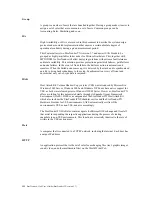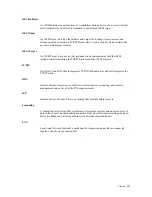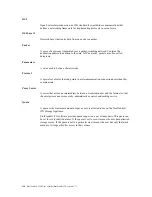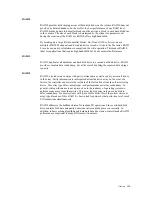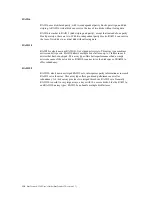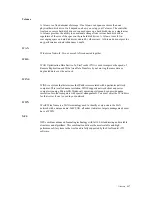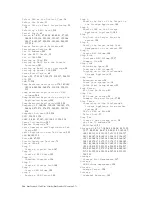
StorTrends® 1300 User’s Guide (StorTrends iTX version 2.7)
334
SMB
Server Message Block. Provides a method for client applications in a computer to read
and write to files on and to request services from server programs in a computer network.
SMB can be used over the Internet on top of its TCP/IP protocol or on top of other
network protocols such as Internet Packet Exchange (IPX) and NetBEUI.
Snapshot
A snapshot service gives you a nearly instantaneous virtual copy of your storage volume
with no interruption of service. The underlying backup technology creates an
instantaneous copy of the data being backed up. This is typically accomplished by
splitting a mirrored set of disks or creating a copy of a disk block when it is written,
preserving the original. At restore time, the original is made available immediately,
resulting in almost instantaneous restores.
Snapshot Rollback
When data has become irretrievably corrupt (due to a virus, for example), or has been
destroyed entirely (for example, if a disk is accidentally formatted, or the like), the
administrator has no choice but to perform a “rollback” from a snapshot onto the volume.
In a rollback operation, the administrator has the ability to essentially select a snapshot
from a list of those currently available and rewrite it to the target, so as to replace the
entire contents of the volume. The most important criterion for rollback is that it must
take as little time as possible. The term RTO, or Recovery Time Objective, is commonly
used in the storage industry to describe this criterion. In highly available servers, the
optimal RTO is one that is as near to zero as possible, since the amount of time needed
for a rollback is equal to the amount of time that service is interrupted.
SNIC
Storage Network Interface Card. SNIC defines a card that supports the iSCSI protocol.
To support iSCSI, a NIC card only needs to provide the ability for SCSI block commands
to be transferred over TCP/IP. An SNIC does not define whether or not the card
incorporates TCP/IP offload features and fully integrates the TCP/IP stack.
SNMP
Short for Simple Network Management Protocol, a set of protocols for managing
complex networks. The first versions of SNMP were developed in the early 80s. SNMP
works by sending messages, called protocol data units (PDUs), to different parts of a
network. SNMP-compliant devices, called agents, store data about themselves in
Management Information Bases (MIBs) and return this data to the SNMP requesters.
Summary of Contents for ManageTrends 2.7
Page 18: ...StorTrends 1300 User s Guide StorTrends iTX version 2 7 xviii...
Page 24: ...StorTrends 1300 User s Guide StorTrends iTX version 2 7 6...
Page 33: ...Chapter Two Chassis Set Up 15 Accessing the Inside of the System...
Page 60: ...StorTrends 1300 User s Guide StorTrends iTX version 2 7 42...
Page 64: ...StorTrends 1300 User s Guide StorTrends iTX version 2 7 46...
Page 70: ...StorTrends 1300 User s Guide StorTrends iTX version 2 7 52...
Page 100: ...StorTrends 1300 User s Guide StorTrends iTX version 2 7 82...
Page 106: ...StorTrends 1300 User s Guide StorTrends iTX version 2 7 88 Control Panel...
Page 236: ...StorTrends 1300 User s Guide StorTrends iTX version 2 7 218...
Page 256: ...StorTrends 1300 User s Guide StorTrends iTX version 2 7 238...
Page 277: ...Appendix E Replication Overview 259 Snap Assisted Replication Navigating with ManageTrends...
Page 281: ...Appendix E Replication Overview 263 Replication SAR view Primary Box SAR view Secondary Box...
Page 285: ...Appendix E Replication Overview 267 After Failover Operation in Secondary Box...
Page 300: ...StorTrends 1300 User s Guide StorTrends iTX version 2 7 282...
Page 308: ...StorTrends 1300 User s Guide StorTrends iTX version 2 7 290...
Page 330: ...StorTrends 1300 User s Guide StorTrends iTX version 2 7 312...
Page 356: ...StorTrends 1300 User s Guide StorTrends iTX version 2 7 338...



